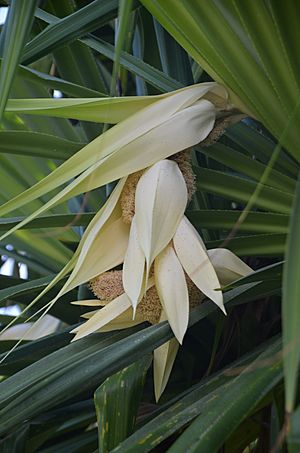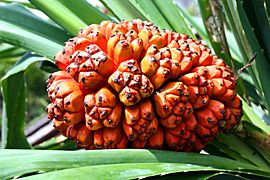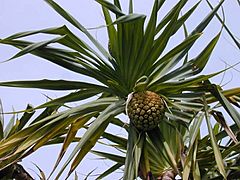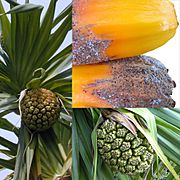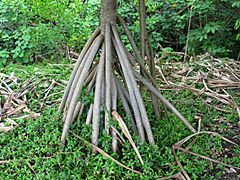Pandanus tectorius facts for kids
Quick facts for kids Pandanus tectorius |
|
|---|---|
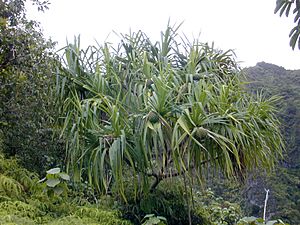 |
|
| Growing in the mountains of Oʻahu in Hawaii | |
| Scientific classification | |
| Genus: |
Pandanus
|
| Species: |
tectorius
|
| Synonyms | |
|
List
|
|
The Pandanus tectorius is a type of Pandanus plant, also known as the screwpine. It grows naturally in parts of Asia and Australia, and on many islands in the Pacific Ocean. You can usually find it in coastal areas, often close to the ocean.
Some common names for this plant are thatch screwpine, Tahitian screwpine, hala tree, or just pandanus. In Hawaii, it's called pu hala. Its fruit is sometimes known as hala fruit.
Contents
What is a Pandanus Tree?
P. tectorius is a small tree that stands tall, reaching about 4 to 14 meters (13 to 46 feet) high. Its main trunk is thin with brown bark that has rings. The trunk can be spiny and grows about 4.5 to 11 meters (15 to 35 feet) wide. It often splits into branches at a height of 4 to 8 meters (13 to 26 feet).
The tree is held up by special prop roots. These roots grow from the trunk and branches, anchoring the tree firmly to the ground. They spread out widely from the trunk.
Pandanus Flowers
Pandanus tectorius trees are either male or female. This means male and female flowers grow on separate trees. The flowers look very different from each other.
Male flowers are small, smell nice, and only last for one day. They grow in groups of three, surrounded by large, white leaf-like parts called bracts. These flower clusters are about 30 centimeters (1 foot) long and have a strong smell.
Female flowers look a bit like pineapples. In Hawaii, the male flower is called hīnano. The bracts from these flowers are used to make very fine mats.
Pandanus Fruit
Female P. tectorius trees grow a large fruit that is divided into many parts. Even though it's not related to a pineapple, the fruit looks similar.
The fruit can be round, oval, or egg-shaped. It measures about 4 to 20 centimeters (1.5 to 8 inches) across and 8 to 30 centimeters (3 to 12 inches) long. Each fruit is made of 38 to 200 wedge-shaped pieces called phalanges, or "keys." These keys have a tough, fibrous outer layer and are about 20 centimeters (8 inches) long.
A single fruit usually has 40 to 80 keys. The fruit can be yellow, orange, or red, with a green top. Each key typically holds two seeds, but can have up to eight. The keys can float, and their seeds can stay alive for many months while traveling on ocean currents.
Pandanus Leaves
The leaves of Pandanus tectorius are usually 90 to 150 centimeters (3 to 5 feet) long and 5 to 7 centimeters (2 to 3 inches) wide. They have edges that look like saw blades. Some types of Pandanus have spines along their edges and veins. The leaves grow in a spiral pattern at the ends of the branches.
Where Pandanus Trees Grow
Pandanus tectorius grows naturally from the Philippines across the Pacific Ocean to Hawaii. You can find it in parts of Malesia (like the Cocos (Keeling) Islands and the Philippines), throughout Papuasia, and in most tropical Pacific islands. In Australia, it grows from Port Macquarie in New South Wales up to northern Queensland.
It's hard to know exactly where this plant first came from because people have grown it for a very long time. It might have been brought to many isolated Pacific islands by early Polynesian travelers. In Hawaii, P. tectorius was present before humans arrived. Scientists found seeds and pollen from the plant in Kauaʻi's Makauwahi Cave.
Pandanus Habitat
Pandanus tectorius naturally grows in coastal areas. This includes places like mangrove edges and beaches. It can grow from sea level up to about 610 meters (2,000 feet) high. The plant needs 1500 to 4000 millimeters (59 to 157 inches) of rain each year. It can handle both wet and dry seasons.
These trees are tough and can survive drought better than coconut trees. They adapt to dry times by producing less fruit. Thatch Screwpine grows well in many types of soil found on coasts. This includes sand, peat, limestone, and basalt.
P. tectorius can handle salt and strong winds. It prefers soil that is slightly acidic to basic, with a pH of 6-10. The trees are strong and can usually survive tropical storms. They like full sunlight but can grow well with some shade (30-50%). However, they won't grow if there is more than 70% shade.
Pandanus Ecology
Many natural enemies can harm P. tectorius trees. These include parasites, pathogens (diseases), and herbivores (animals that eat plants). They can attack the leaves, roots, stems, and growing tips of the plant. For example, the stick insect Megacrania batesii lives and eats only on P. tectorius and two other Pandanus species.
In Australia, a sap-sucking insect called Jamella australiae threatens Pandanus tectorius. This insect, known as the Pandanus planthopper, has caused a lot of damage. It has killed about 80% of the P. tectorius trees south of Gladstone, Queensland. These trees are important for preventing coastal erosion.
To fight this pest, a natural predator, a wasp called Aphanomerus pusillus, has been introduced. This wasp is native to northern Queensland. Other ways to control the pest include injecting insecticide into the plants, removing infested leaves, and growing new plants from local healthy stock.
Growing Pandanus Trees
Pandanus tectorius plants grown from seeds usually start to flower around 15 years old. However, trees grown from branch cuttings flower much earlier, often by 3 to 4 years old, and always by 6 years old.
Male trees flower every two months, while female trees typically flower 1 to 3 times a year. It is believed that these trees reproduce sexually in Hawaii. Small insects, like bees, and wind help with pollination. It takes 1 to 2 years for female trees to produce fruit after pollination.
The fruiting seasons change depending on the location and type of tree. For example, in Fiji, pollination happens from March to May. In Northern Australia, it's from April to August. In Micronesia, there are two seasons: December to March and July to September. Most types of Pandanus produce 8 to 12 fruits per tree every two years. Each fruit usually weighs between 7 and 15 kilograms (15 to 33 pounds) and contains 35 to 80 edible keys.
How to Plant Pandanus Seeds
In Hawaii, Pandanus tectorius plants are usually grown from seeds. To do this, soak the fruit keys in cool tap water for five days, changing the water often. The keys that float are the ones that can grow. It's important to remove the fleshy part of the key. Then, bury the seed halfway in planting soil and keep the soil moist.
Growing from Cuttings
P. tectorius can also be grown from large cuttings. In Micronesia, people choose branches with aerial roots. They trim off two-thirds of the leaves to prevent water loss. For best results, use mature branches that have leaves and small aerial roots. Then, root them in a bed of sand. Plants grown from cuttings will produce fruit in 4 to 6 years.
Uses of the Pandanus Tree
The fruit of Pandanus tectorius can be eaten. Some types of fruit have a lot of calcium oxalate, which means they need to be cooked well before eating. Other types have very little calcium oxalate and can be eaten raw. This fruit is a very important food source on the atolls (ring-shaped islands) of Micronesia and Polynesia. People often eat the fruit raw or turn it into a dried paste or flour. It's also a traditional food in Maldivian cuisine. The fibrous fruit can even act like natural dental floss!
In Samoan culture, the dried fruit is painted red and made into a necklace called a ula fala. This necklace is worn by leaders during special events. Australian Aboriginal people also ate the slender, edible seeds and the fruit.
The tree's leaves are often used to add flavor to sweet dishes, like kaya jam. In Sri Lankan cooking, the leaves flavor many different curries. Polynesians used the leaves to make baskets, mats, outrigger canoe sails, thatch roofs, and grass skirts.
The male flowers smell very nice and are used to make perfumes. They are also distilled to create a fragrant oil called Kewra.
This large shrub or small tree is very important for culture, health, and the economy in the Pacific. It is second only to the coconut tree on atolls. It grows wild in coastal areas, where it can handle dry weather, strong winds, and salt spray. It easily grows from seeds, but people also plant it from branch cuttings for farms and home gardens. It grows quite fast, and every part of the plant is used. This includes the nutritious fruits, the poles and branches for building, and the leaves for weaving and making garlands. The plant is a big part of Pacific culture and traditions, including local medicine.
There are hundreds of different types of cultivated Pandanus trees, known by their local names. Each type has unique fruits, branches, and leaves. Sadly, this variety is decreasing. Some types are becoming hard to find. This is happening because fewer people are replanting them, and due to deforestation, fires, less interest from younger generations, and fast population growth leading to more cities.
Cultural Significance
The seal of Punahou School in Honolulu, Hawaii, features the hala tree. This is partly because lauhala, the art of weaving with the leaves of this tree, is a very important part of Hawaiian history. People used lauhala to make everything from houses to pillows.
A local legend tells of an old Hawaiian couple who lived long ago above the Punahou campus. They had to travel far to get water. They prayed every night for a spring, but nothing happened. Finally, one night, in a dream, they were told to pull up the stump of an old hala tree. They did as they were told and found a spring of clear, sweet water. They named it Ka Punahou, which means "the New Spring." According to the legend, Punahou School's lily pond is still fed by this same spring.
Gallery
See also
 In Spanish: Pandanus tectorius para niños
In Spanish: Pandanus tectorius para niños






